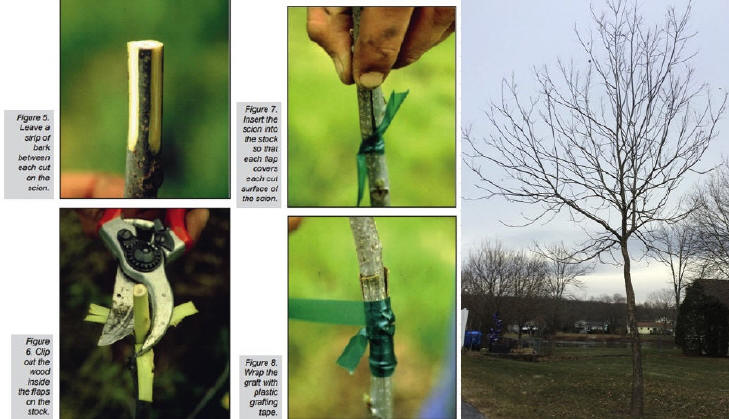Bill Devlin
Adams County Master Gardener

First, the "not to" portion appears at the end of this article.
Grafting historically dates from about 2000 BC in China. My grafting experience only dates to 1983 when I first had pecan grafting done by a friend on my ‘river bottom’ farm in southeast Kansas. Since then I attended grafting schools held by Dr. Bill Reid, director of the Kansas State University Pecan Experiment Station near Chetopa, Kansas, about
30 miles south of my farm in Labette County Kansas.
Dr. Reid authored the following treatise on grafting nut trees from which some of the illustrations are taken and is a proponent of the 3-flap grafting method. Looking from the end of a grafting scion, you will see that the buds are formed 120 degrees apart, or one third of a circle, thus 3 flaps versus 4 in earlier practice.
http://www.centerforagroforestry.org/pubs/proppecbw.pdf
Why Graft? Grafting is done for two primary reasons, variety selection, and rapid production. The latter occurs by eliminating the adolescent period of a trees growth. This is accomplished by grafting a mature scion, taken from a mature producing limb from a desired variety and grafting it to a couple of years old seedling. If that isn’t done, it
may be 15 years for the seedling to grow through adolescence to maturity. Instead, its producing in 5 years or less.

Seedlings are obtained by collecting healthy pecans (or desired species) and "stratifying" by keeping in an airtight moist container in a refrigerator, or burying in a shallow moistened pit for the winter. The stratified seeds are then placed in a suitable container or "tree pot" filled with potting soil for several months, then planting them.
After about two years when they are 1/4" thick they are ready for grafting to the scion.
The scion is a piece of wood of suitable size taken from near the end of a limb’s last year’s growth during dormancy, February for example, and kept moist in an airtight container in a refrigerator free from apples.
The detailed steps are best learned from the above treatise. A few excerpts are included in the composite picture along with a grafted Pawnee about 15 years old in my front yard.
How not to graft pecan trees?
While I have grafted successfully for about 30 years, last year it was a spectacular failure. So much so that I feel compelled to apologize and document the reason so that it doesn’t happen again. While the treatise referenced above is very good, it does not mention one factor that tripped me up this year.
I have developed a sweet tooth for the Gala variety of apple, to the extent that I buy large bags of them and keep them in the bottom of my refrigerator, near my bags of pecan scions that I collect in February.
This fall I attended a Kansas Forestry Association Field Day held at a large tree farm in Towanda Kansas. The tour also included a visit to their newly established pecan grove. During Dr. Reid’s discussion of the grove he pointed out the practice of collecting scions during the winter dormant phase, and casually mentioned that the scions must not
be stored in a refrigerator with apples, as ethylene gas will destroy the viability of tree buds.
An excerpt from Wikipedia on Ethylene:
Ethylene is thought of as the aging hormone in plants. In addition to causing fruit to ripen, it can cause plants to die. It can be produced when plants are injured, either mechanically or by disease. Ethylene will cause a wide range of effects in plants, depending on the age of the plant and how sensitive the plant is to ethylene. Ethylene
effects include fruit ripening, loss of chlorophyll, abortion of plant parts, stem shortening, abscission of plant parts, and epinasty (bending of stems).
I offer my sincere apology to those who I grafted for or gave scions to this past year. If desired I will graft again with guaranteed ethylene free scions. You may contact me at Devlinw1@aol.com.
Read other articles about trees
Read other articles By Bill Devlin